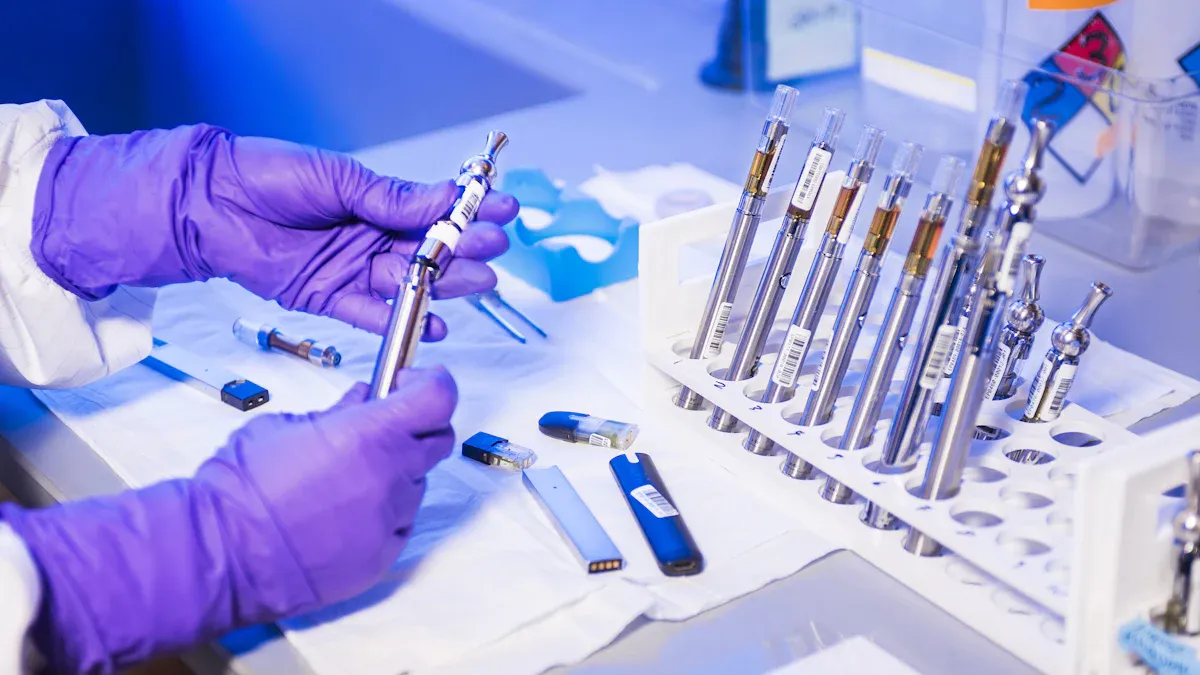Top Tips for Choosing Nitinol Tubing for Stent Grafts

Nitinol tubing for stent grafts is essential for the success of these medical devices. It plays a significant role in treating thoracoabdominal aortic aneurysms. The unique properties of nitinol tubing make it both strong and flexible, which are critical qualities needed for endovascular aortic repair. Research indicates that larger stent areas, such as 13.5 cm², may reduce corrosion resistance, potentially impacting long-term outcomes. Selecting the appropriate nitinol tubing for stent grafts enhances stent functionality, improves repair effectiveness, and ultimately benefits patients. In active blood vessels, nitinol tubing for stent grafts proves to be highly reliable, making it vital for addressing challenging aneurysm cases.
Key Takeaways
Pick nitinol tubing because it bends easily and remembers shapes. These qualities help stents fit blood flow and work well during repairs.
Choose the correct thickness and size for stents. Good sizing makes them strong and bendable, lowering the chance of problems in surgery.
Team up with suppliers to make stents for special needs. Custom designs fit better and work well, helping patients in tough aortic cases.
Key Material Properties of Nitinol Tubing for Stent Grafts

Superelasticity and Shape Memory
Nitinol tubing is special because it is superelastic and has shape memory. These qualities help nitinol stents adjust to the moving aortic system. The tubing can go back to its original shape after bending or stretching. This helps self-expanding stents stay strong under blood flow pressure. Superelasticity also lowers the chance of stents collapsing, making them dependable for aortic repairs. These features are very important for balloon-expandable stents, which need to be placed carefully and stay steady.
Biocompatibility and Corrosion Resistance
Biocompatibility means nitinol stents are safe for the human body. Corrosion resistance stops the stents from breaking down over time. Research shows that the size of nitinol tubing affects its corrosion resistance. For instance, Rahimipour et al. (2020) found that bigger stent areas might not prevent hypersensitivity. Ryhänen et al. (1997) studied nitinol in cell cultures and confirmed it is safe for the body. However, Sivan et al. (2017) found that corrosion pits can cause cracks, which may weaken stents over time.
Study Reference | Findings | Notes |
|---|---|---|
Rahimipour et al. (2020) | Larger stent areas affect corrosion resistance | Bigger areas may cause hypersensitivity issues |
Ryhänen et al. (1997) | Nitinol is biocompatible in cell cultures | Shows it is safe for the body |
Sivan et al. (2017) | Corrosion pits can weaken stents | Cracks may form, reducing long-term strength |
Fatigue Resistance and Long-Term Durability
Fatigue resistance helps stents handle the constant movement of blood vessels. Blood flow puts stress on stents, but nitinol tubing is strong enough to handle it. This makes sure both self-expanding and balloon-expanding stents work well over time. Covered stents especially need to stay strong for a long time. Picking nitinol tubing for stent grafts ensures the device stays reliable, even in tough conditions.
Precision in Dimensions for Best Performance
Wall Thickness and Diameter Details
When picking nitinol stents, size matters a lot. Wall thickness and diameter affect how well the stent works. Thin walls make stents more flexible to move with blood vessels. But they still need to be strong enough to handle blood pressure. The diameter must fit the aorta's size perfectly. If it's too small, the stent might slip out of place. If it's too big, it could harm the vessel walls. Choosing the right size helps the stent work safely and effectively.
Importance of Tolerances and Consistency
Exact measurements are key when choosing stents. Small size mistakes can cause problems during surgery. For example, uneven walls might stop the stent from expanding properly. This could make it unstable. Consistent sizes help the stent fit well in the aorta. This lowers the chance of it moving or failing. Manufacturers use special tools to make sure stents meet strict size rules. Always check that the nitinol tubing you pick follows these rules.
Customization for Aortic Repairs
Custom stents are important for tricky aortic repairs. Specially made stents can solve problems like odd aorta shapes or high blood pressure. Studies show smaller stent areas resist corrosion better, lasting longer.
Surface Area | Corrosion Resistance Effect |
|---|---|
Larger | Lower corrosion resistance |
Smaller | Better corrosion resistance |
Also:
Stents with one ring resist damage better.
Stents with many rings may fail under stress.
Working with suppliers lets you design stents for your needs. Custom stents fit better and last longer in the body.
Ensuring High Manufacturing Quality
Compliance with Medical-Grade Standards
It is important to pick nitinol tubing that meets medical rules. These rules make sure the stent is safe and works well. For example:
ISO 10993-1 checks if materials are safe for the body.
ASTM F2063 ensures nitinol is strong and resists rust.
FDA 510(k) compares device performance for faster market approval.
Standard/Regulation | What It Ensures |
|---|---|
ISO 10993-1 | Safe for contact with body fluids. |
ASTM F2063 | Strong and rust-resistant nitinol. |
FDA 510(k) | Faster approval by comparing performance. |
Quality system for medical devices. | |
USP Class VI | Safe plastic parts for medical use. |
Using certified tubing ensures the stent is safe and reliable in the body.
Surface Treatments for Corrosion Resistance
Stopping rust is key to making stents last longer. Special surface treatments like electropolishing (EP) help a lot. Research shows EP-treated tubing breaks down less than other finishes like anodized (AO) or chemically etched (CE). For example, EP-treated tubing stays strong even when its surface area is over 5 cm². Other finishes often fail at this size.
Always choose tubing with advanced surface treatments. These treatments prevent rust and lower the chance of stent damage over time.
Quality Control and Testing Protocols
Good manufacturing needs strict quality checks and tests. Companies like GEE SMA and Dynalloy follow ISO 13485:2016, a global medical device standard.
Manufacturer | Quality Standard | What They Check |
|---|---|---|
GEE SMA | ISO 13485:2016 | Strict quality checks. |
Dynalloy | ISO 13485:2016 | Reliable and consistent testing. |
Look for tubing that meets MDR rules for faster approval. Trusted makers test for size accuracy, strength, and rust resistance. These steps ensure the stent works well, even in tough blood vessel conditions.
Application-Specific Considerations for Stent Grafts

Compatibility with Human Anatomy and Physiology
When picking nitinol stents, they must fit the body well. The stent's size and flexibility should match the aorta's shape. Self-expanding stents adjust easily to moving blood vessels. Balloon-expandable stents are great for precise placement in tight spots. Covered stents stop blood from leaking into damaged vessel walls. Choosing the right stent helps it fit better and improves patient health.
Performance in Dynamic Vascular Environments
Aortic stents handle constant blood flow and vessel movement. Nitinol stents work well because they are flexible and strong. Smaller stents, like 0.34 cm², resist rust better than larger ones, like 13.5 cm². This makes smaller stents last longer in tough conditions. Covered stents are built to handle these challenges for years. Picking the right stent ensures it works well in active blood vessels.
Collaboration with Suppliers for Tailored Solutions
Working with suppliers helps create stents for special needs. Custom stents fix problems like odd aorta shapes or high blood pressure. Suppliers can change wall thickness, size, or surface treatments to make a perfect fit. This teamwork makes stents last longer and work better. Partnering with skilled makers improves repairs and helps patients recover faster.
Picking the best nitinol tubing improves results for aortic aneurysms. Look at material strength, exact sizes, and good manufacturing. Work with skilled suppliers to create custom stents for your needs. Talking to experts ensures better repairs, especially for aortic surgeries.
FAQ
Why is nitinol tubing good for stent grafts?
Nitinol tubing is flexible, strong, and safe for the body. These features help stents fit blood vessels and work well for aneurysm treatments.
How does nitinol tubing help with aneurysm repair?
Nitinol tubing keeps stents strong and bendable. This lets them handle blood flow and lowers risks during aneurysm repairs.
Can nitinol stents work in moving blood vessels?
Yes, nitinol stents are great for active blood vessels. They resist wear and rust, making them dependable for tough aneurysm cases.
See Also
A Comprehensive Approach to Choosing Nitinol Tubing
Finding the Ideal Nitinol Tubing Supplier for You
The Manufacturing Process of Nitinol Tubing for Medicine
The Importance of Nitinol Tubing in Minimally Invasive Surgery

